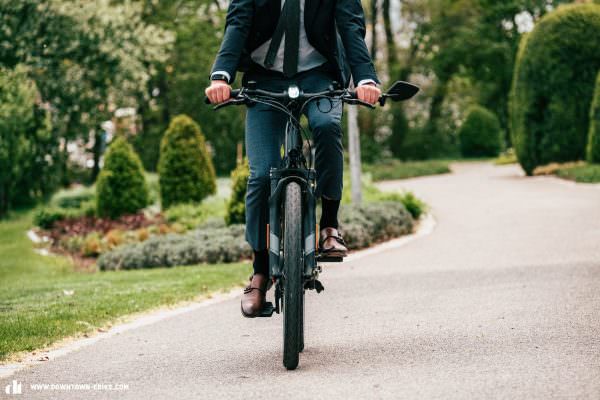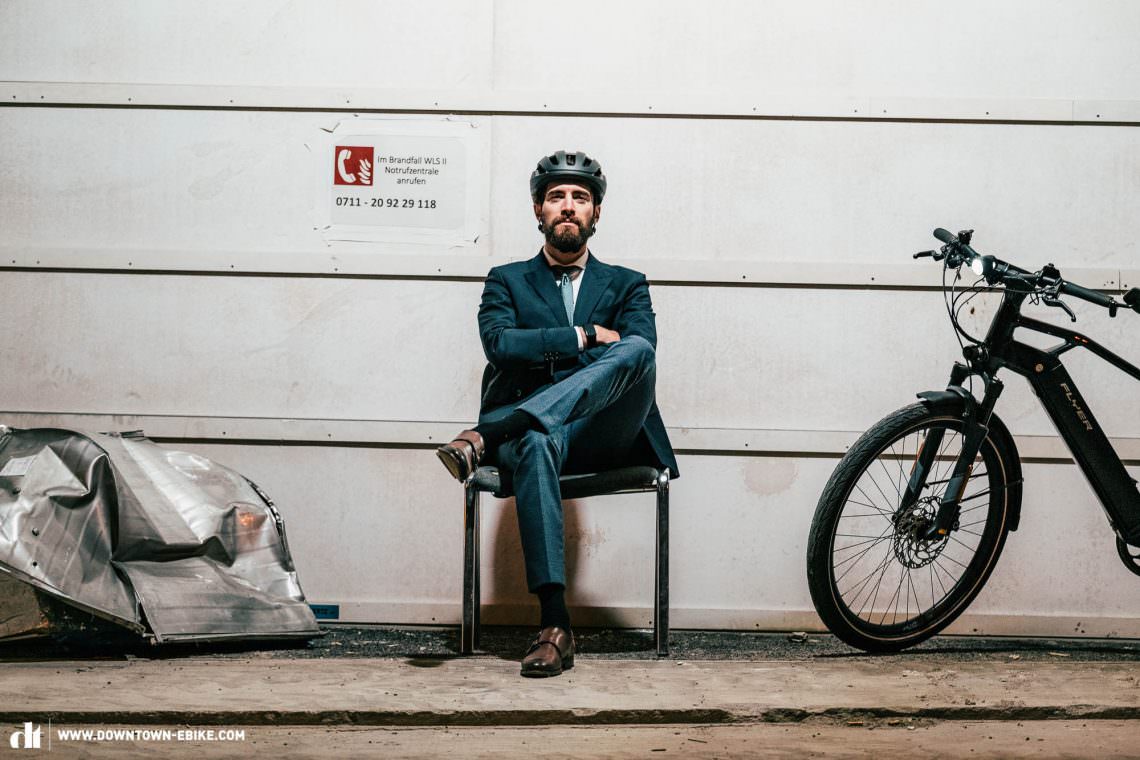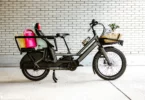A massive battery, a motor perfectly tuned for the flats and wide 27.5″ tires: the FLYER Upstreet 6 7.10 HS has the potential to clean up in the big commuter bike group test. Does the S-pedelec make the cut or is it unable to emerge from the test unscathed? You can find out here.
Get an overview of the grouptest here: The best ebike of 2021 – The 19 most exciting concepts for everyday use

32.24 kg in size L | € 5,099 | Manfacturer’s website
Escape from the daily rush hour that steals away precious minutes from the ever smaller amount of free time available both before and after work. Leave the bitter fight for the last parking space to others. Swap increased stress for the refreshing wind blowing through your hair. FLYER promise all this with the Upstreet6 7.10 HS, one of three S-pedelecs in our big ebike group test. The Swiss brand goes against the mid-motor trend with a rear-wheel-drive – common for sports cars like Porsche or Jaguar to allow for more agile handling. We found out whether the Upstreet benefits from this too.
If you expect Swiss quality in terms of looks, you’ll be disappointed by the front of this bike. It’s a bustle of too many cables and chaos reigns.


FLYER Upstreet6 7.10 HS spec in detail
Form follows function – that must have been the motto during the development of the € 5,099 FLYER Upstreet. The massive, reinforced frame, hefty welds and fat chainstays leave no doubt that the Upstreet can deal with all the forces exerted on an S-pedelec at 45 km/h without any issues. And that turns out to be the case: the aluminium frame of the FLYER bike is decidedly stiff and is completely unimpressed even when loaded up maximally with 116 kg. Unfortunately, chaos reigns in the cockpit. Clearly, the ergonomic and cable routing experience of the Swiss brand has been inspired by Italian cuisine and, as such, emanates spaghetti flair. The Swiss promise of quality gleaming on the top tube couldn’t stand in starker contrast to the front of the FLYER, where numerous cables cross wildly and make a mockery of the idea of integration. Even the adjustable stem and solid mount for the FIT D1 display can only do so much to rectify the damage. Things are different on the frame and rear of the ebike: here all the cables and hoses run tidily inside. Unusual for an S-pedelec is the lack of four-piston brakes and the associated reserves – nonetheless, we didn’t have any problems during our testing. However, during long descents, which in hilly Switzerland stack up like binged Netflix series during a pandemic, the MAGURA MT4e brakes can reach their limit – the bike alone weighs an impressive 32 kg.

With its joystick and 3.5″ display, the FLYER Upstreet fulfils all requirements for a small Nintendo game. However, the ergonomics of the joystick to control the energy recovery mode are a bit fiddly.

With a label of Swiss Quality Assembly, we expect anything but the cable routing of the cockpit, which just doesn’t do the bike justice.

With 50 teeth, the chainring is too big and together with the comparatively weak motor, makes the FLYER Upstreet unsuitable for hilly terrain.
FLYER Upstreet6 7.10 HS
€ 5,099
Specifications
Motor TDCM HCA45 37 Nm
Battery FLYER FIB-810 810 Wh
Display FIT D1
Fork SR Suntour MOBIE45 60 mm
Seatpost FLYER Alu 31.6 mm
Brakes MAGURA MT4e 203/180 mm
Drivetrain Shimano DEORE 1x10
Stem FLYER Integrated Stem 95 mm
Handlebar SATORI Wien 640 mm
Wheelset FLYER Disc
Tires Continental CONTACT Plus City 27.5 x 2.2"
Technical Data
Size S M L XL
Weight 32.24 kg
Specific Features
recuperation mode
FIT D1 display
ABUS SHIELD 5650L frame lock

The 810 Wh FLYER FIB battery is one of the biggest single batteries of all the test bikes.

The push-assist of the FLYER Upstreet is neither particularly powerful nor reliable and gave up multiple times during the test.

When it comes to tidiness, the Upstreet6 could have taken an example from the wall behind it. The cable routing at the front of the S-pedelec is chaotic.
| Size | S | M | L | XL |
|---|---|---|---|---|
| Seat tube | 440 mm | 480 mm | 520 mm | 560 mm |
| Top tube | 565 mm | 590 mm | 615 mm | 640 mm |
| Head tube | 130 mm | 150 mm | 170 mm | 190 mm |
| Head angle | 70.5° | 70.5° | 70.5° | 70.5° |
| Seat angle | 73.0° | 73.0° | 73.0° | 73.0° |
| Chainstays | 480 mm | 480 mm | 480 mm | 480 mm |
| BB Drop | 45 mm | 45 mm | 45 mm | 45 mm |
| Wheelbase | 1,104 mm | 1,130 mm | 1,156 mm | 1,182 mm |
| Reach | 384 mm | 403 mm | 423 mm | 442 mm |
| Stack | 591 mm | 610 mm | 629 mm | 648 mm |

DThe TDCM hub motor of the FLYER Upstreet: Forwards with a roar?
For the drive system, FLYER rely on a hub motor. It is provided by Taiwanese manufacturer TDCM and propels the Upstreet with a comparatively limited 37 Nm. The TDCM HCA5 motor is fueled by one of the biggest batteries in the test: the FLYER FIB with an 810 Wh capacity. In comparison to many other batteries that are hidden in the down tube, it can be removed from the side, making charging much easier. Unfortunately, during the test, the TDCM motor revealed a number of issues. The motor pushes the bike gently and isn’t very aggressive. That makes the FLYER Upstreet6 easy for newbies to master even without much of a learning curve. Acceleration and power in the mid-range are completely acceptable and you can happily ride the FLYER Upstreet6 7.10 HS on the flats at a constant 45 km/h without breaking a sweat. In contrast, that’s only possible with the Riese & Müller Homage with significantly more of your own input. However, when a hill appears, you’ll need to take as big a run-up as possible. If your speed drops and you end up pedalling with an ever lower cadence, the support of the motor disappears quickly and you’ll be left pedalling on your own without any support. Setting off on a hill is also almost impossible with the FLYER Upstreet.



The lower power compared to a mid-motor is a limitation of the design and common to numerous hub motors. In combination with the comparatively low torque, the FLYER just can’t keep up with the competition in these situations. The limited power of the push assist adds to this difficulty, regularly overwhelmed on steps and on top of that, ended up having numerous malfunctions and showing faults on the display.
You want to fly over the flats at 45 km/h and feel the wind blowing through your hair? The FLYER Upstreet6 7.10 HS is your bike!
Once you’ve managed to climb a hill, you can enjoy the energy recovery system on the way downhill. With the integrated motor brake, it’s possible to recover some energy to feed the battery and charge it during your ride. Unfortunately, this only works at low speeds for a longer period of time; above 40 km/h, the system switches off quite quickly to protect the battery. The usability of the energy recovery mode via the joystick on the bars isn’t really intuitive. One of the few highlights of the E-drive is the large and clear FIT D1 display, which can be paired with your smartphone and app like Komoot and provide you with turn indications – unfortunately, there’s not a complete map like on the Bosch Nyon display.

FLYER Upstreet6 7.10 HS on test
As mentioned previously, the FLYER is easy to keep at speed on the flats but, as an S-pedelec, can’t legally be ridden on bike or forest paths in Germany, which should be clear anyway if you buy a Speed-pedelec. As a result of the hub motor, the Upstreet is lighter at the front than the rear which has an influence on both the handling and comfort of the bike. As such, the mass of the bike pushes noticeably from behind when riding over bumps. Despite the stiff triangle, the bike isn’t uncomfortable and is able to offer a decent level of damping thanks to the 27.5 x 2.2″ Continental tires. Small vibrations are damped effectively but big hits are transmitted almost unfiltered onto the rider. The SR Suntour suspension fork is specially designed for 45 km/h bikes and can be specced for a surcharge of 250 CHF instead of the rigid fork – we’d advise doing so because it’s worth the money and shines with good damping.


Tuning tip: tip to the manufacturer: please fit easier gears that will match the comparatively limited motor power

The FLYER Upstreet reacts willingly to steering input and in some situations demands a certain amount of rider experience. At high speeds, the sensitive bike wants to be steered with a careful hand and led gently through corners. On the other hand, at low speed, the Upstreet is easy to ride intuitively without too much thought required from beginners. At very low speeds i.e. when standing or pushing, the overall handling of the bike is comparatively difficult to manage as a result of the inadequate push-assist. Due to the high weight of 32 kg and its rear-heavy distribution, the bike is anything but handy. The FLYER Upstreet6 7.10 HS is only suitable if you have to overcome hardly any climbs on the way to work, never ride off-road and are looking for a bike with a big battery for commuting that can cruise at speed on the flats.
FLYER Upstreet6 7.10 HS conclusion
With its large battery and hub motor, the FLYER Upstreet6 7.10 is predestined for long rides on the flats and effortlessly maintains its cruising speed of 45 km/h. However, the S-pedelec is shy on hills and strikes almost completely as things get steeper. On top of that, it’s stubborn when pushed and the cable routing at the front is chaotic. That means the Upstreet6 can only score in a relatively limited range of applications and, unfortunately, disappointed us during this test.
Tops
- one of the biggest batteries in the test
- great motor tuning for the flats
- clear FIT D1 display with Komoot integration
Flops
- weak response at low cadences or from a standstill
- difficult handling when standing or pushing the bike
- chaotic cable routing up front
- too hard gearing for the torque available
- narrow range of applications
Rider Type
6You can find out more about at flyer-bikes.com

The testfield
Get an overview of the grouptest here: The best ebike of 2021 – The 19 most exciting concepts for everyday use
All Bikes in this group test: Ampler Stout (Click for review) | Brompton M6L Cloud Blue (Click for review) | Cannondale Topstone Neo Carbon Lefty LE (Click for review) | Canyon Commuter:ON 7 (Click for review) | Diamant Juna Deluxe+ (Click for review) | FEDDZ E-Moped (Click for review) | FLYER Upstreet6 7.10 HS | Haibike Trekking 9 (Click for review) | Kalkhoff Endeavour 5.B Excite+ (Click for review) | MERIDA eBIG.TOUR 700 EQ (Click for review) | MERIDA eONE SIXTY 10K (Click for review) | Moustache Samedi 27 Xroad FS 7 (Click for review) | Movea Modo 20” (Click for review) | Riese & Müller Homage GT Rohloff HS mit DualBattery (Click for review) | Riese & Müller Packster 70 Vario (Click for review) | Riese & Müller Roadster Touring (Click for review) | Schindelhauer Arthur VI/IX (Click for review) | Specialized Turbo Vado SL 5.0 EQ (Click for review) | VanMoof X3 (Click for review)

… or the regular long-distance commuters. Your usual commuting distance is more than 15 km each way and you use your bike every day. Your ebike is used as a means of transport and is a real alternative to a second car or public transport. Practicality, reliability and utility win out over the ultimate bling factor because it’s primarily a functional machine↩
This type of ebike unites experts and early adopters from both the fashion and tech scenes. As hip trendsetters, they know exactly how to ride with style. Sci-fi, hi-fi, Wi-Fi – they know exactly what they’re talking about and can easily play the keyboard while half asleep. With a tendency to live out their passions eccentrically, emotional decisions come before rational ones.↩
Take the kids to kindergarten, head to the weekly market and later get a crate of beer – no problem for this type of ebike, even without a car. These riders love to combine things: rational and emotional motives go hand in hand because investments are made on the basis of knowing what they want and getting a suitable vehicle that suits their vision and mission.↩
You live in a 15-minute city like Paris. This means that all your daily needs are within a 15-minute radius by foot or ebike. For short distances of less than 2 km, you aren’t afraid to simply walk. For medium distances of up to 10 km, you get on your bike. Longer distances are easily covered with a mix of public transport and your bike. Short-distance bikers are active/sporty people who never want to commit to one thing, maintain a flexible lifestyle and like to be inspired by impulses. Due to limited space in the city, they often don’t have a car and if they do, it is mainly used for pleasure.↩
You have significant biking experience and enjoy riding sportily. This group encompasses mountain bikers and trail shredders, road bike fans and Strava heroes, as well as touring fans who enjoy (rural) excursions into the countryside outside the city. You change into sports gear for your daily commute before showering when you get there because you enjoy working on your fitness. Your bike is used for commuting during the week as well as for tours at the weekend and is a means of transport and sports equipment all in one.↩
Learn more about the different rider types in this article: Click here! ↩
Words: Aaron Steinke Photos: Valentin Rühl







